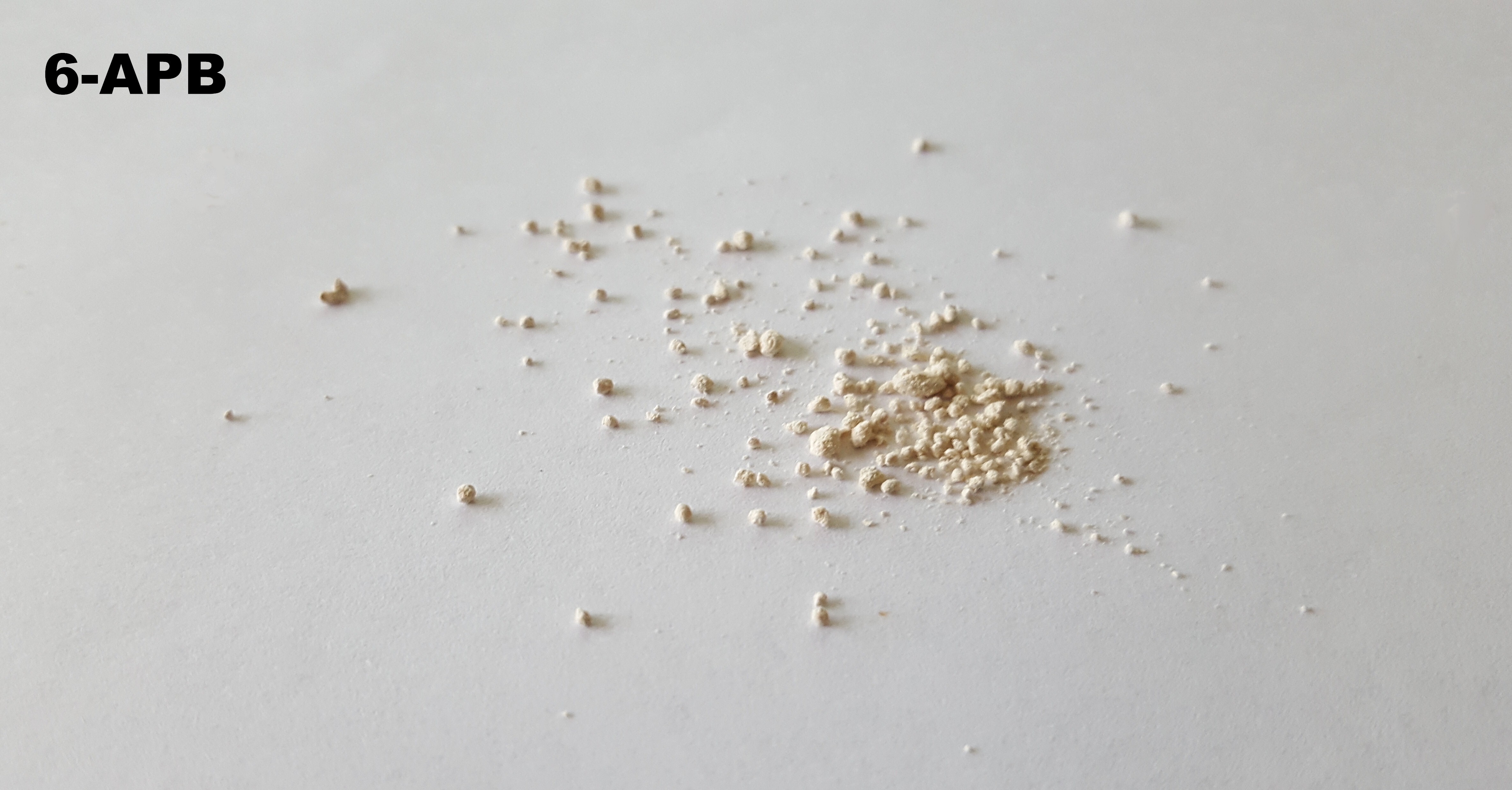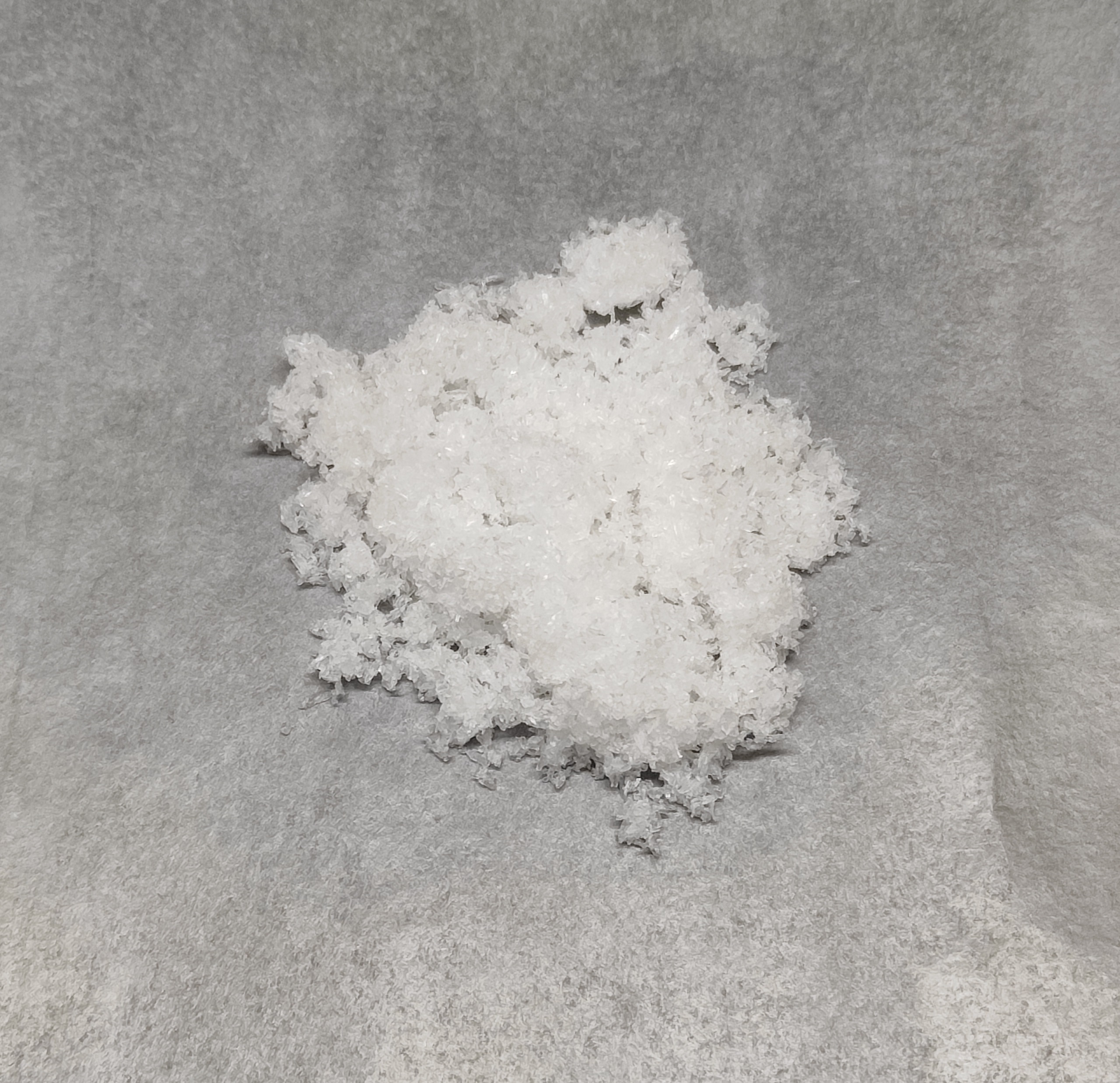|
6-APB
6-APB (6-(2-aminopropyl)benzofuran) is an empathogenic psychoactive drug of the substituted benzofuran and substituted phenethylamine classes. 6-APB and other compounds are sometimes informally called "Benzofury" in newspaper reports. It is similar in structure to MDA, but differs in that the 3,4- methylenedioxyphenyl ring system has been replaced with a benzofuran ring. 6-APB is also the unsaturated benzofuran derivative of 6-APDB. It may appear as a tan grainy powder. While the drug never became particularly popular, it briefly entered the rave and underground clubbing scene in the UK before its sale and import were banned. It falls under the category of research chemicals, sometimes called "legal highs” if uncontrolled. Because 6-APB and other substituted benzofurans have not been explicitly outlawed in some countries, they are often technically legal, contributing to its popularity. Use 6-APB can be found in freebase, hydrochloride, and succinate form. The free ... [...More Info...] [...Related Items...] OR: [Wikipedia] [Google] [Baidu] |
Entactogen
Entactogens, also known as empathogens or connectogens, are a class of psychoactive drugs that induce the production of experiences of emotional communion, oneness, connectedness, emotional openness—that is, empathy—as particularly observed and reported for experiences with MDMA. This class of drug is distinguished from the classes of hallucinogens or psychedelics and stimulants, although entactogens, for instance MDMA, can also have these properties. Entactogens are used both as recreational drugs and are being investigated for medical use in the treatment of psychiatric disorders, for instance MDMA-assisted therapy for post-traumatic stress disorder (PTSD). Notable members of this class include MDMA, MDA, MDEA, MDOH, MBDB, 5-APB, 5-MAPB, 6-APB, 6-MAPB, methylone, mephedrone, αMT, αET, and MDAI, among others. Most entactogens are phenethylamines and amphetamines, although several, such as αMT and αET, are tryptamines. When referring to MDMA and its cou ... [...More Info...] [...Related Items...] OR: [Wikipedia] [Google] [Baidu] |
Substituted Benzofuran
The substituted benzofurans are a class of chemical compounds based on the heterocyclic compound, heterocyclic and polycyclic compound, polycyclic compound benzofuran. Many medicines use the benzofuran core as a scaffold, but most commonly the term is used to refer to the simpler compounds in this class which include numerous psychoactive drugs, including stimulants, psychedelic drug, psychedelics and empathogen-entactogen, empathogens. In general, these compounds have a benzofuran core to which a 2-aminoethyl group is attached (at any position), and combined with a range of other substituents. Some psychoactive derivatives from this family have been sold under the name ''Benzofury (other), Benzofury''. List of substituted benzofurans The derivatives may be produced by substitutions at six locations of the benzofuran molecule, as well as saturation of the 2,3- double bond. The following table displays notable derivatives that have been reported: Legislation Su ... [...More Info...] [...Related Items...] OR: [Wikipedia] [Google] [Baidu] |
6-APDB
6-(2-Aminopropyl)-2,3-dihydrobenzofuran (6-APDB, 4-Desoxy-MDA, EMA-3) is a stimulant and entactogen drug of the phenethylamine and amphetamine classes. It is an analogue of MDA where the heterocyclic 4-position oxygen from the 3,4-methylenedioxy ring has been replaced with a methylene bridge. 5-APDB (3-Desoxy-MDA) is an analogue of 6-APDB where the 3-position oxygen has been replaced with a methylene instead. 6-APDB, along with 5-APDB, was first synthesized by David E. Nichols in the early 1990s while investigating non-neurotoxic MDMA analogues. Pharmacology In animal drug discrimination studies, 6-APDB fully substitutes for MBDB and MMAI but not for amphetamine or LSD. ''In vitro'', 6-APDB has been shown to inhibit the reuptake of serotonin, dopamine, and norepinephrine with IC50 values of 322 nM, 1,997 nM, and 980 nM, respectively. These values are very similar to those of MDA, but with those for the catecholamines slightly lower in comparison, perhaps more similarly t ... [...More Info...] [...Related Items...] OR: [Wikipedia] [Google] [Baidu] |
Serotonin–norepinephrine–dopamine Releasing Agent
A serotonin–norepinephrine–dopamine releasing agent (SNDRA), also known as a triple releasing agent (TRA), is a type of drug which induces the release of serotonin, norepinephrine/epinephrine, and dopamine in the brain and body. SNDRAs produce euphoriant, entactogen, and psychostimulant effects, and are almost exclusively encountered as recreational drugs. A closely related type of drug is a serotonin–norepinephrine–dopamine reuptake inhibitor (SNDRI). Examples of SNDRAs Examples of SNDRAs include specific amphetamines such as MDMA, MDA, 4-methylamphetamine, methamphetamine (in high doses), certain substituted benzofurans such as 5-APB and 6-APB, naphthylisopropylamine; cathinones such as mephedrone and methylone; tryptamines such as αMT and αET; along with agents of other chemical classes such as 4,4'-DMAR, and 5-IAI.Bruce E. Blough, Richard Rothman, Antonio Landavazo, Kevin M. Page, Ann Marie Decker. Phenylmorpholines and analogues thereof. US Patent 2013/0 ... [...More Info...] [...Related Items...] OR: [Wikipedia] [Google] [Baidu] |
Benzofury (other)
Benzofury may refer to: * 5-APB * 5-MAPB * 6-APB 6-APB (6-(2-aminopropyl)benzofuran) is an empathogenic psychoactive drug of the substituted benzofuran and substituted phenethylamine classes. 6-APB and other compounds are sometimes informally called "Benzofury" in newspaper reports. It is ... * 6-MAPB {{disambig ... [...More Info...] [...Related Items...] OR: [Wikipedia] [Google] [Baidu] |
Substituted Phenethylamine
Substituted phenethylamines (or simply phenethylamines) are a chemical class of organic compounds that are based upon the phenethylamine structure; the class is composed of all the derivative (chemistry), derivative compounds of phenethylamine which can be formed by replacing, or substitution reaction, substituting, one or more hydrogen atoms in the phenethylamine core structure with substituents. Phenylethylamines are also generally found to be central nervous system stimulants with many also being entactogens/empathogens, and hallucinogens. Structural classification The structural formula of any substituted phenethylamine contains a phenyl group, phenyl ring that is joined to an amino group, amino (NH) group via a two-carbon substituent, sidechain. Hence, any substituted phenethylamine can be classified according to the substitution of hydrogen atom, hydrogen (H) atoms on phenethylamine's phenyl ring, sidechain, or amino group with a moiety (chemistry), specific group of at ... [...More Info...] [...Related Items...] OR: [Wikipedia] [Google] [Baidu] |
Psychoactive Drug
A psychoactive drug, psychopharmaceutical, mind-altering drug, consciousness-altering drug, psychoactive substance, or psychotropic substance is a chemical substance that alters psychological functioning by modulating central nervous system activity. Psychoactive and psychotropic drugs both affect the brain, with psychotropics sometimes referring to psychiatric drugs or high-abuse substances, while “drug” can have negative connotations. Designer drug, Novel psychoactive substances are designer drugs made to mimic illegal ones and bypass laws. Psychoactive drug use dates back to prehistory for medicinal and consciousness-altering purposes, with evidence of widespread cultural use. Many animals intentionally consume psychoactive substances, and some traditional legends suggest animals first introduced humans to their use. Psychoactive substances are used across cultures for purposes ranging from medicinal and therapeutic treatment of Mental disorder, mental disorders and pain, ... [...More Info...] [...Related Items...] OR: [Wikipedia] [Google] [Baidu] |
Free Base
In chemistry, a free base (freebase, free-base) is a term for the neutral form of an amine or other Lewis base. The term is used in the pharmaceutical industry in contrast to salt-based formulations like hydrochlorides. The amine is often an alkaloid, such as nicotine, cocaine, morphine, and ephedrine, or derivatives thereof. Colloquially, "free-basing" also means the treatment of salts or other formulations to convert them into the free base form, especially for recreational drugs. Properties Some alkaloids are more stable as ionic salts than as free base. The salts usually exhibit greater water solubility. Common counterions include chloride, bromide, sulfate, phosphate, nitrate, acetate, oxalate, citrate, and tartrate. Amine salts formed from the acid–base reaction with hydrochloric acid are known as hydrochlorides. For example, compare the free base hydroxylamine (NH2OH) with the salt hydroxylamine hydrochloride (NH3OH+ Cl−). Freebasing Cocaine hydrochloride ("p ... [...More Info...] [...Related Items...] OR: [Wikipedia] [Google] [Baidu] |
Succinate
Succinic acid () is a dicarboxylic acid with the chemical formula (CH2)2(CO2H)2. In living organisms, succinic acid takes the form of an anion, succinate, which has multiple biological roles as a metabolic intermediate being converted into Fumaric acid, fumarate by the enzyme succinate dehydrogenase in complex 2 of the electron transport chain which is involved in making Adenosine triphosphate, ATP, and as a signaling molecule reflecting the cellular metabolic state. Succinate is generated in mitochondria via the citric acid cycle, tricarboxylic acid (TCA) cycle. Succinate can exit the mitochondrial matrix and function in the cytoplasm as well as the extracellular space, changing gene expression patterns, modulating epigenetic landscape or demonstrating hormone-like signaling. As such, succinate links cellular metabolism, especially ATP formation, to the regulation of cellular function. Dysregulation of succinate synthesis, and therefore ATP synthesis, happens in some genetic m ... [...More Info...] [...Related Items...] OR: [Wikipedia] [Google] [Baidu] |
Hydrochloride
In chemistry, a hydrochloride is an acid salt resulting, or regarded as resulting, from the reaction of hydrochloric acid with an organic base (e.g. an amine). An alternative name is chlorhydrate, which comes from French. An archaic alternative name is muriate, derived from hydrochloric acid's ancient name: muriatic acid. Uses Converting amines into their hydrochlorides is a common way to improve their water solubility, which can be desirable for substances used in medications. The European Pharmacopoeia lists more than 200 hydrochlorides as active ingredients in medications. These hydrochlorides, compared to free bases, may more readily dissolve in the gastrointestinal tract and be absorbed into the bloodstream more quickly. Additionally, many hydrochlorides of amines have a longer shelf-life than their respective free bases. Amine hydrochlorides represent latent forms of a more reactive free base. In this regard, formation of an amine hydrochloride confers protection ... [...More Info...] [...Related Items...] OR: [Wikipedia] [Google] [Baidu] |




